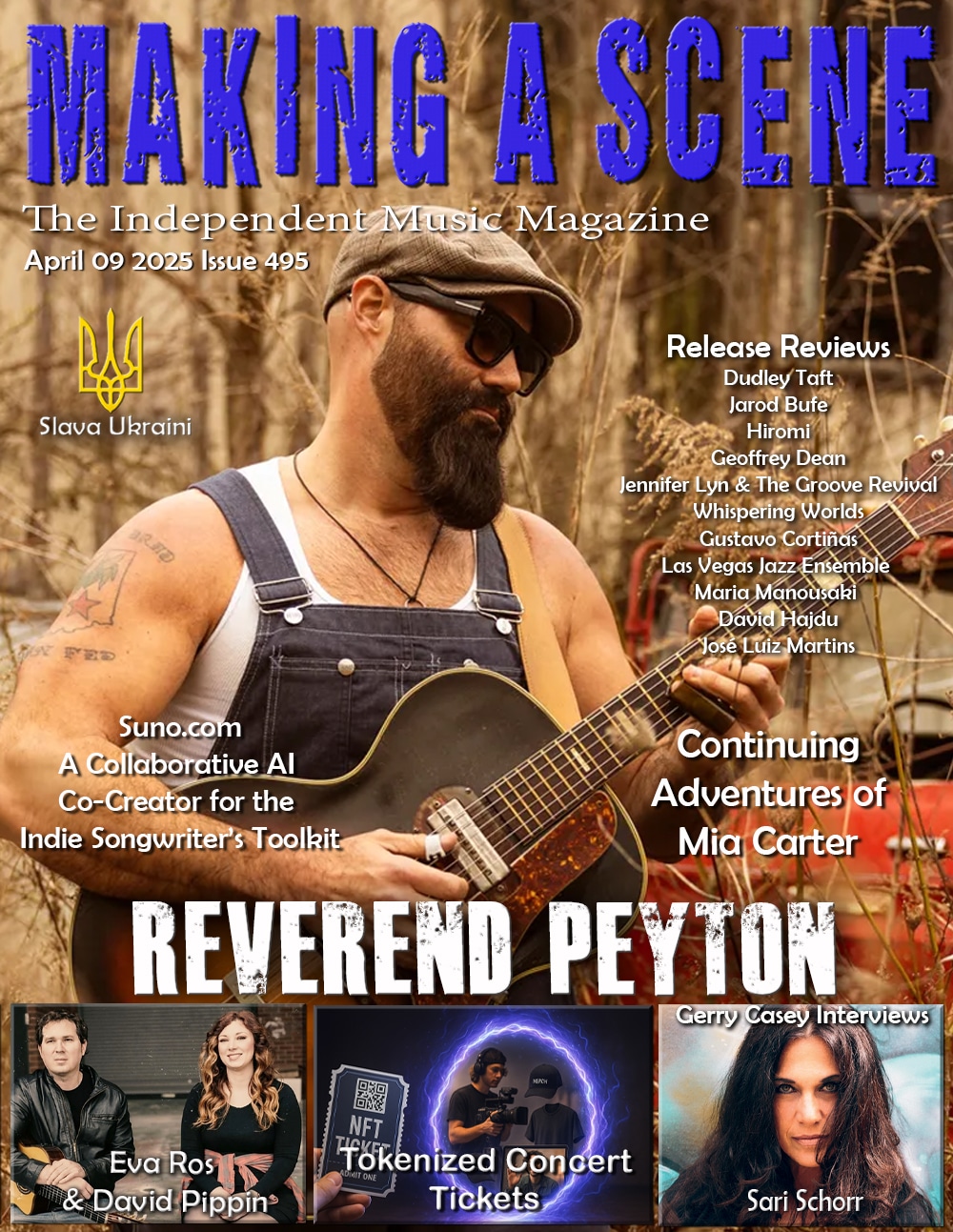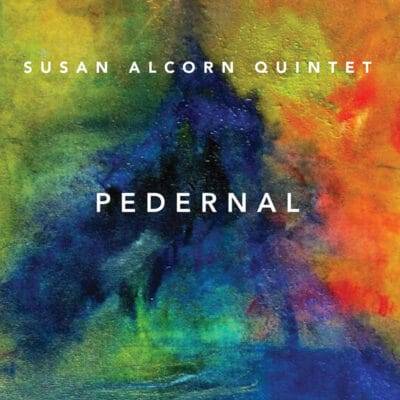Susan Alcorn Pedernal
Pedernal
Relative Pitch
One does not think of the pedal steel guitar in the context of jazz with few exceptions, the prime example being the versatile Greg Leisz who is part of Charles Lloyd’s Marvels. Enter the creative, trailblazing Susan Alcorn, who like most associated with the instrument, had her beginnings in country music, only to later take the instrument on a genre blurring course. While Alcorn has a history of solo and duo performances as well as large ensembles and as a side-woman, Pedernal is her debut as leader of a quintet. This introduces the Baltimore-based pedal steel player with her own, beautifully crafted explorative compositions.
Alcorn teams with guitarist Mary Halvorson (of which she is a member of the Mary Halvorson Octet), bassist Michael Formanek, violinist Mark Feldman, and drummer Ryan Sawyer. She has worked with Formanek and Sawyer before too. Feldman is the only new collaborator, an artist she has longed to work with after seeing him perform with pianist Sylvie Courvoisier a few years ago. Feldman has been associatied with creative artists ranging from John Abercrombie to John Zorn. Given her familiarity with these players, the arrangements and musical choices were made with them in mind.
Retreating to a remote casita in New Mexico for a month, Alcorn soaked in the natural splendor, particularly the iconic mesa for which she named the album. Pedernal is not necessarily designed to evoke the landscape of the Southwest, but Alcorn conceived the title track while communing with the stark grandeur of the mountain. Her tendency is to think orchestrally in her compositions, partly due to her experience in large ensembles but mostly because of the instrument itself. “With the pedal steel guitar, it’s like having your own orchestra,” she says. “If played in a certain way you can fill the whole sound universe so that you’re not missing anything else.”
Regarding her musical background in her early days playing country and western music, Alcorn started playing guitar at the age of 12 and quickly immersed herself in folk music, blues, and the pop music of the 1960s. A chance encounter with blues musician Muddy Waters steered her towards playing slide guitar. By 21, she was immersed in the pedal steel guitar, playing in country and western swing bands in Texas. She spent years performing in honky-tonks around Houston but was always interested in a wide array of styles and traditions.
As an improviser with a penchant for more thrilling edgy material, she listened closely to Ornette Coleman, John and Alice Coltrane, and Albert Ayler, “who have a lot to do with how I hear things, how I improvise, and how I write,” Alcorn says. She’s been particularly inspired by Coleman’s harmolodics, where “the melody and its improvisations are not being defined by a chord progression,” she says. “In this way, each note has its own harmonic voice which could fit a rather large array of dyads and chords. In some ways, it’s in the same lineage as Schoenberg and the Second Viennese school.”
She credits her experience with composer, accordionist and “Deep Listening” philosopher Pauline Oliveros with opening new possibilities. When Oliveros described Alcorn’s debut album Uma as her favorite release in an interview with the British magazine The Wire, “all of the sudden all these people from Europe started calling,” Alcorn says. “At home I was doing a gig of my own once every four months, and then suddenly I played the London Festival of Improvised Music, which was the first opportunity I had to perform my solo music outside of Houston.” If there’s a thread running through her disparate projects, it’s the heightened sense of promise and purpose in each note. “I view the instrument I play, the pedal steel guitar, not as an object to be mastered,” she says, “but as a partner with which to share with the listener a meaning, depth, and hopefully profound awareness of each unique moment we’re together.”
Pedernal opens with Alcorn’s slithery pedal steel line suggesting a dark, minor blues that’s joined in by Formanek’s lithe bass. Descending chords introduce the second section as the band steps into the gathering maelstrom, eventually resolving into a grandiose lyrical theme that seems to summon the power of the iconic vista. Inspired by Anasazi dwellings in southeastern Utah’s Hovenweep National Monument, another spectacular setting, the spacious, almost 10-minute “Circular Ruins” hovers and skitters in the air, offering another communion with awe. The music impresses with a lightness, seemingly familiar melodies that at times sound like mashups of several genres. The pace picks up with the playful, inventive “R.U.R” which takes its name from Czech writer Karel Čapek’s 1920 science fiction play R.U.R., which stands for Rossum’s Universal Robots.
“A Night in Gdansk,” the album’s centerpiece, is a 13-minute explorative piece that displays both the full range of her instrument’s possibilities and the breadth of her compositional considerations. She wrote the first half as a solo piece for pedal steel during an uneasy evening in the Polish port and orchestrated it for the quintet. Her love of Olivier Messiaen, surfaces in some of the thick, shimmering chords. She wrote the second half in New Mexico, devising a grand Romantic theme that showcases Feldman’s expressive violin. The album closes with “Northeast Rising Sun,” a title that might sound like a pastoral scene from her New Mexico sojourn but is lifted from highway exit signs Alcorn often passes while driving on I-95 in Maryland. It begins with the quintet sharing some laughter before they soon break into hand claps behind Alcorn’s pedal steel melody enjoined first by Feldman and then Halvorson. The theme expands on a refrain often used in the devotional Sufi tradition known as Qawwali but can just as easily be viewed as an amalgam of American musical themes, including some children songs, and clearly some country music. Formanek’s bass solo is especially evocative and the tune comes off not necessarily as jazz but just a joyous, uplifting piece.
One might think that this music is rather inaccessible given the respective backgrounds of some of the players and the cited influences that Alcorn draws from. Yet, in fact, it is surprisingly accessible with emotional layers that give it both beauty and feeling.
- Jim Hynes
Buy Us a Cup of Coffee!
Join the movement in supporting Making a Scene, the premier independent resource for both emerging musicians and the dedicated fans who champion them.
We showcase this vibrant community that celebrates the raw talent and creative spirit driving the music industry forward. From insightful articles and in-depth interviews to exclusive content and insider tips, Making a Scene empowers artists to thrive and fans to discover their next favorite sound.
Together, let’s amplify the voices of independent musicians and forge unforgettable connections through the power of music
Make a one-time donation
Make a monthly donation
Make a yearly donation
Buy us a cup of Coffee!
Or enter a custom amount
Your contribution is appreciated.
Your contribution is appreciated.
Your contribution is appreciated.
DonateDonate monthlyDonate yearlyYou can donate directly through Paypal!
Subscribe to Our Newsletter
Discover more from Making A Scene!
Subscribe to get the latest posts sent to your email.
















































